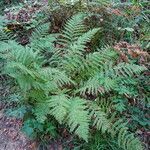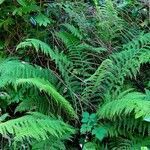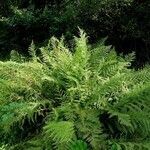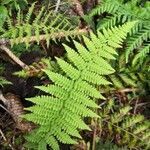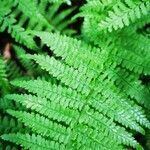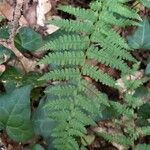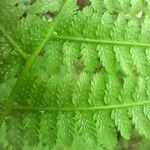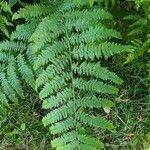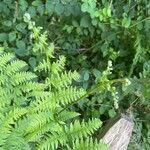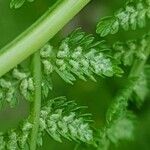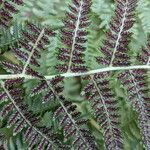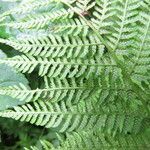Rhizome short-creeping to suberect, the lvs clustered near its tip, 4–10 dm; blade 10–35 cm wide, acuminate, slightly reduced below, sparsely scaly, otherwise glabrous or minutely glandular, mostly bipinnate or bipinnate-pinnatifid; pinnae 20–30 pairs below the pinnatifid tip, lance-linear, subsessile, attenuate-acuminate, the pinnules mostly serrate to deeply parted, obtuse to acuminate; veins forking, directed into the teeth; indusia dark brown, thin, ciliate (at least when young) mostly short and ± curved or hooked, commonly crossing the veins; 2n=80. Moist woods, meadows, and streambanks; cosmopolitan and highly variable, two vars. in our area:
Rhizomes short, erect, stout, densely clothed with brown scales. Stipes 10-20 cm long, scaly especially at base, green or purplish red. Laminae elliptic or narrowly elliptic, 2-3-pinnate at base, 45-100 × 18-40 cm. Primary pinnae in up to 30 pairs, narrowly ovate, the longest about middle of lamina, to 25 × 4 cm. Secondary pinnae narrowly ovate, to 2 cm long. Sori 1-2 mm long, ± oblong, the lower ones hooked, the upper straight, in rows either side of midrib of secondary pinnae, nearer midrib than margin, protected by persistent flap-like indusia.
A clumping fern. It grows 45-90 cm high and wide. The fronds arise from erect rhizomes. They are usually divided into long pointed leaflets. They are finely divided and brittle. They break easily. It loses its fronds in winter months. There are many cultivated varieties.
